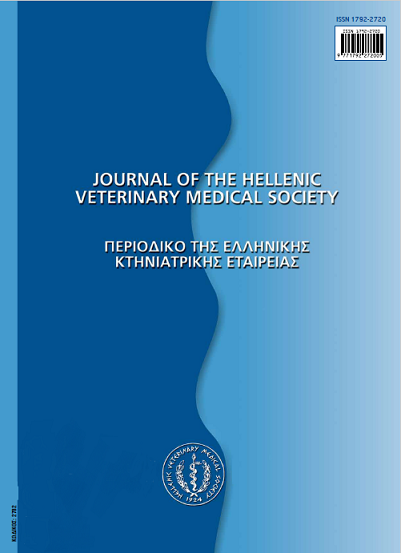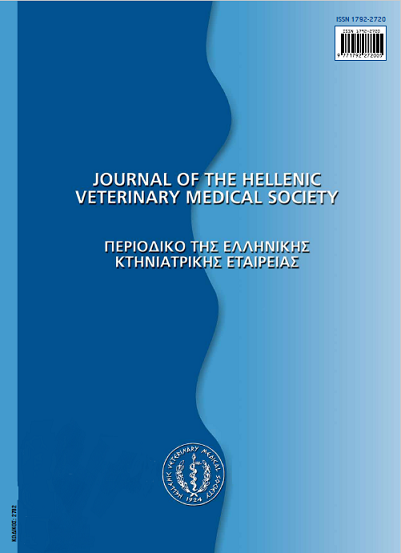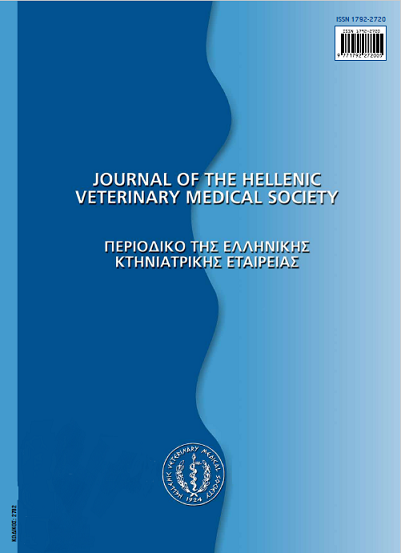Determination of breakthrough maternal antibodies titres by two intermediate and two intermediate plus vaccine strains against Gumboro disease, in commercial broilers
Abstract
Two field trials (termed A and B) were carried out on 4 farms (groups) with 20,000 broilers each. The groups in A and Β were named Al, A2, A3, A4 and Bl, B2, B3, B4, respectively. The chicks in A were hatched from breeders of 39, 43, 46, and 56 weeks-old and in Β from 27, 31, 52, and 54 weeks-old. One vaccination to each group was administered against Gumboro in drinking water, in each trial. Intermediate plus vaccines I and II were used in groups 1 and 2 and intermediate I and II in groups 3 and 4. In A the vaccinations were conducted when the chicks were 15-days-old and in Β at 19-days-old. In both trials blood samples were collected at 8, 15, 19, 23, 30 and 37 days of age. Serum examinations by ELISA established that in groups Al, A2, A3 and A4 vaccinations were carried out in the presence of mean maternal antibody titres 7.1 log2, 7.2 log2, 6.3 log2 and 6.4 log2, respectively. A regression of antibodies up to 37 days were observed in these 4 groups. In groups Bl, B2, B3 and B4 the vaccinations were carrie out in the presence of mean maternal antibody titres 7.3 log2, 7.4 log2,3.2 log2 and 3.3 log2, respectively. A strong serological response from 30 days was observed in these 4 groups. It is remarkable that intermediate plus vaccines to 7.3log2 and 7.41og2 mean maternal antibody titres caused active immune response in groups Bl and B2, respectively, contrary to what happened to similar titres in groups Al and A2. This important observation showed that age may be one of the main factors that influences the effectiveness of vaccinations, as well as the interference of maternal antibodies and the virulence of vaccines strains. The results of both field trials indicate that both intermediate vaccines at 15-days-old did not breakthrough mean maternal antibody titres higher than 6.3 log2, whereas intermediate plus vaccines succeded to breakthrough mean maternal antibody titres lower than 7.4 log2 at 19-days-old.
Article Details
- Zitationsvorschlag
-
BOUGIOUKLIS (Π. ΜΠΟΥΠΟΥΚΛΗΣ) P., GEORGOPOULOU (Ι. ΓΕΩΡΓΟΠΟΥΛΟΥ) I., & IORDANIDIS (Π. ΙΟΡΔΑΝΙΔΗΣ) P. (2017). Determination of breakthrough maternal antibodies titres by two intermediate and two intermediate plus vaccine strains against Gumboro disease, in commercial broilers. Journal of the Hellenic Veterinary Medical Society, 55(3), 217–225. https://doi.org/10.12681/jhvms.15097
- Ausgabe
- Bd. 55 Nr. 3 (2004)
- Rubrik
- Research Articles
Authors who publish with this journal agree to the following terms:
· Authors retain copyright and grant the journal right of first publication with the work simultaneously licensed under a Creative Commons Attribution Non-Commercial License that allows others to share the work with an acknowledgement of the work's authorship and initial publication in this journal.
· Authors are able to enter into separate, additional contractual arrangements for the non-exclusive distribution of the journal's published version of the work (e.g. post it to an institutional repository or publish it in a book), with an acknowledgement of its initial publication in this journal.
· Authors are permitted and encouraged to post their work online (preferably in institutional repositories or on their website) prior to and during the submission process, as it can lead to productive exchanges, as well as earlier and greater citation of published work.













